| < Prev | Next > |
|---|
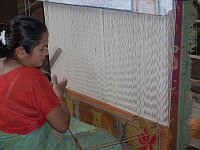 This page is an accompanying text by artelino for a video produced by the Carpet and Wool Development Board of Nepal and available on the artelino web site by courtesy of Nepal Carpet Industries. The video is 13 minutes long and demonstrates the labor-intensive process of making a carpet in the Tibetan weaving tradition in Nepal.
This page is an accompanying text by artelino for a video produced by the Carpet and Wool Development Board of Nepal and available on the artelino web site by courtesy of Nepal Carpet Industries. The video is 13 minutes long and demonstrates the labor-intensive process of making a carpet in the Tibetan weaving tradition in Nepal.
Story of a Rug from Nepal
The video is understood in all languages. It is subdivided into the below chapters. With the following text I want to comment the different steps a bit based on my own experience.
Carding
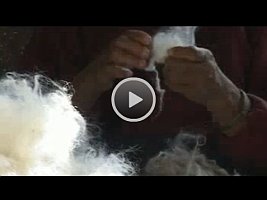 The video shows carding of the wool by hand. Machine-carding is more common today. It does even provide a smoother wool. Hand-carded wool is slightly cheaper.
The video shows carding of the wool by hand. Machine-carding is more common today. It does even provide a smoother wool. Hand-carded wool is slightly cheaper.
From an aspect of quality machine-spun wool is slightly better. However hand-spun wool gives more people an income.
Spinning
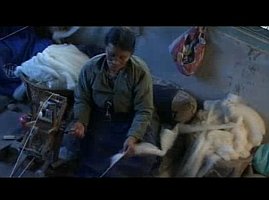 Spinning is still done by hand. The spinning wheels shown in the video are called "charkha". The spinning process determines the thickness of the yarn and thus the density of the knots per square inch.
Spinning is still done by hand. The spinning wheels shown in the video are called "charkha". The spinning process determines the thickness of the yarn and thus the density of the knots per square inch.
Dyeing
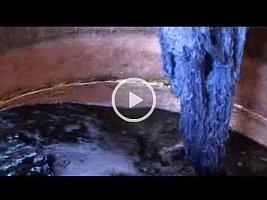 Synthetic colors have begun to replace the natural/vegetable colors already at the end of the nineteenth century in Tibet. Today nearly all carpets are made from synthetic colors. Vegetable-dyed carpets are still possible. But the color spectrum is limited and strong colors are no longer easily available.
Synthetic colors have begun to replace the natural/vegetable colors already at the end of the nineteenth century in Tibet. Today nearly all carpets are made from synthetic colors. Vegetable-dyed carpets are still possible. But the color spectrum is limited and strong colors are no longer easily available.
After the coloring the yarn is dried in the sun. This is usually done on the flat roofs of houses.
Weaving
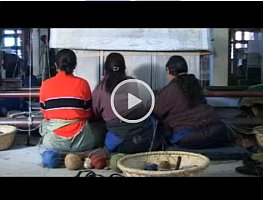 What is generally called weaving is actually not weaving but knotting. The Tibetan knotting technique is unique in the world and completely different from the Persian and the Turkish knot. The Tibetan knotting allows a faster production and a thicker pile. The thick, soft pile makes the Tibetan carpets unique. This is what many buyers of carpets from Nepal appreciate.
What is generally called weaving is actually not weaving but knotting. The Tibetan knotting technique is unique in the world and completely different from the Persian and the Turkish knot. The Tibetan knotting allows a faster production and a thicker pile. The thick, soft pile makes the Tibetan carpets unique. This is what many buyers of carpets from Nepal appreciate.
Rug weaving is still done entirely by hand everywhere in Nepal in contrast to carpets from China which are nowadays nearly exclusively machine-produced.
I do not think that this core process of carpet making in Nepal will be replaced by machines in the near future as long as Nepal remains one of the poorest countries in the world. Machine production would simply be too expensive due to extremely cheap labor in Nepal. Sad, but true.
In the film you can see the use of yarn balls, an iron-rod, a hammer, a comb-beater and a pair of scissors. This is required for the unique technique of the Tibetan knotting. Carpet making is practiced in Nepal either in small manufactures or as a family business. When you stroll in Tibetan quarters in Kathmandu you can often hear the typical sound when the rod is hammered down.
The Tibetan weaving uses a vertical loom. Also this is unique, and not practiced in any other countries with a carpet making tradition like Iran or Turkey.
In the video you can see the "architectural plan" for the rug design that is attached to the loom in front of the worker. Thus they know when to take another yarn color. You may imagine the high skill that is required to make an old traditional design with rich elements - compared to a modern design that often has only a border element and otherwise flat areas.
Washing and Drying
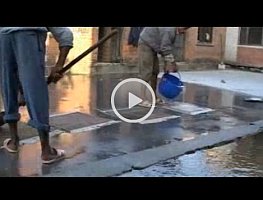 After the weaving is done, the edges are fixed and then the rug is washed in the open air and dried in the sun.
After the weaving is done, the edges are fixed and then the rug is washed in the open air and dried in the sun.
This work is by the way always done by men. I have never seen women doing it. But I have every now and then seen a man sitting in front of a loom weaving.
Stretching
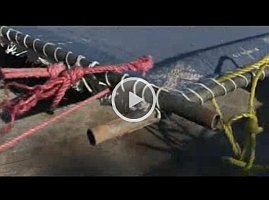 This final process makes sure that the rug will lie even on your floor. This is especially important for large carpets that were rather rare in old Tibet but that have come into existence in the 1970s on demand of Western buyers.
This final process makes sure that the rug will lie even on your floor. This is especially important for large carpets that were rather rare in old Tibet but that have come into existence in the 1970s on demand of Western buyers.
Trimming
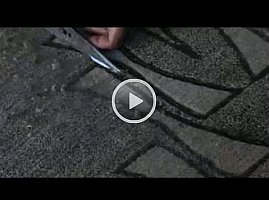 Trimming - or contouring - is the process of incising slightly into the wool pile along the lines of the design elements. This gives the rug an embossed, and thus slightly three-dimensional look. It also makes the lines along the design elements come out sharper and clearer. On client requests rugs are also made without trimming. I personally think a trimmed carpet looks much better.
Trimming - or contouring - is the process of incising slightly into the wool pile along the lines of the design elements. This gives the rug an embossed, and thus slightly three-dimensional look. It also makes the lines along the design elements come out sharper and clearer. On client requests rugs are also made without trimming. I personally think a trimmed carpet looks much better.
Traditional or Modern Designs?
In the video you see mostly modern designs. Artelino offers you only traditional designs in traditional sizes of roughly 3 by 6 feet = circa 90 by 180 centimeters. These designs are made exclusively for us after old carpet patterns.
Dieter Wanczura
(May 2009)







